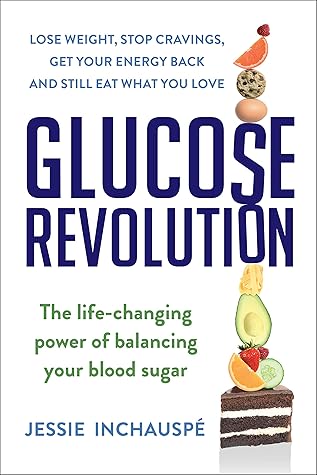More on this book
Community
Kindle Notes & Highlights
Read between
July 10, 2022 - January 18, 2023
we know that food affects how we feel. Science tells us that when people eat a diet that leads to lots of glucose spikes, they report worsening moods over time and more depressive symptoms compared to a diet of similar calories but with flatter curves.
adding fat to a meal does not increase the insulin spike. It does not tell our bodies to secrete more insulin. In fact, eating fat before a carb-rich meal decreases the amount of insulin produced in response to the meal.
When we eat carbohydrates on their own, ghrelin, a hormone that tells us to eat, fluctuates rapidly, then makes us hungrier than we were before eating. Carbs drive our hunger up and down like a roller coaster, while fats and protein don’t.
People with type 1 diabetes don’t have the ability to make enough insulin. Without insulin, when a spike comes in, the glucose can’t make its way into cells properly. So it stays very high in their bloodstream for very long, while the cells are starving for energy.
Good fats are saturated (fat from animals, butter, ghee, and coconut oil) or monounsaturated (from fruit and nuts such as avocados, macadamia nuts, and olives). For cooking, use saturated fats—they’re less likely to oxidize with heat. Monounsaturated fats, such as olive and avocado, can’t stand the heat as well. A good rule of thumb to distinguish between them: cook with fats that are solid at room temperature when you can. Bad fats (which inflame us, hurt our heart health, make us gain visceral fat, and increase our insulin resistance) are polyunsaturated and trans fats, which are found in
...more
when we encounter a decrease in glucose levels, it’s usually because the last thing we ate caused a glucose spike. Yet our brain tells us to do the same thing, to choose high-calorie foods, even though we aren’t famished—we’ve got energy reserves. After a glucose drop, our liver quickly (within 20 minutes) steps in, releases stored glucose from those reserves into our bloodstream, and brings our levels back to normal. At that point, the craving often dissipates. So next time you’re about to grab a cookie, set a timer for 20 minutes. If your craving was due to a glucose drop, it will be gone by
...more
Ingredients are sorted in descending order by weight. If sugar is in the top five ingredients, that means a hefty proportion of that food consists of sugar—a soft white roll, for example, or ketchup—and will cause a glucose spike. If sugar is in the top five ingredients, the food will be sweet, and you know what that means: a hidden fructose spike.
When assessing dry foods, such as cookies, pasta, bread, cereal, cereal bars, crackers, and chips, head to the Total Carbohydrate section. The grams next to Total Carbohydrate and Total Sugars represent the molecules that cause a glucose spike: starches and sugars. The more grams of these, the more the food will lead to a rise in your glucose, fructose, and insulin levels and set off the chain reaction that keeps you craving sweet things.
fiber is the only carbohydrate that our bodies don’t break down—the more fiber in the food, the flatter the glucose curve after eating it. So here’s a tip: for dry foods, look at the ratio of Total Carbohydrate to Dietary Fiber. Select items whose ingredients get the closest to 1 gram of Dietary Fiber for each 5 grams of Total Carbohydrate. Here’s how to do it: find the number next to Total Carbohydrate and divide it by five. Try to find a food that has that amount of Dietary Fiber (or as close to it as possible).


